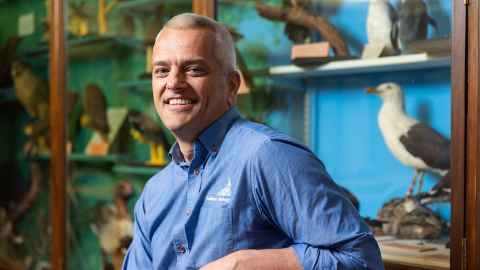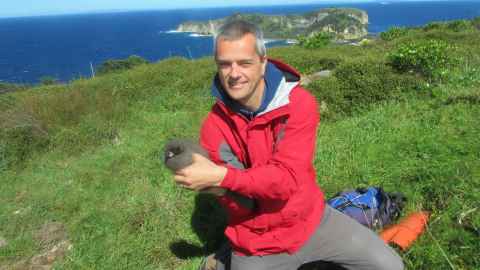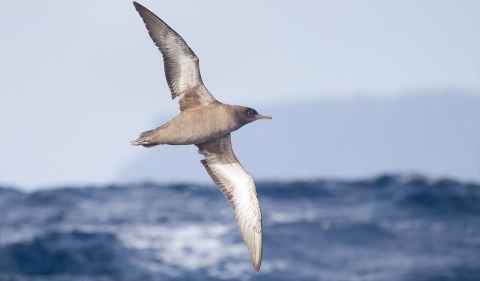Brendon Dunphy: giving seabirds a fighting chance
01 November 2022
Aotearoa New Zealand’s seabirds aren’t well-known like the kākāpō. They often come in at night and then head off out over the horizon.

Dr Brendon Dunphy’s preference was clear when it came to the popular Bird of the Year campaign recently. The tītī got his vote. The weka? Didn’t stand a chance.
He’s unlikely to ruffle any feathers by saying that. The tītī is the focus of many years of Brendon’s research, and he is part of a group recently awarded $1m from the Ministry of Business, Innovation & Employment’s Endeavour Fund to develop predictive tools to improve climate resilience for tītī.
Researchers from Waipapa Taumata Rau will work with Ngāi Tahu, other researchers from Plant and Food Research, the Department of Conservation, Manaaki Whenua Landcare Research and Tāmaki Paenga Hira Auckland War Memorial Museum. Their research will analyse how the effects of climate change, such as warmer waters, and El Niño, which creates warmer ocean surfaces in the Pacific, affect tītī stress levels and therefore breeding, because stress reduces breeding success. The team will also look at whether and why northern tītī colonies are more stressed than southern.
The tītī or sooty shearwater (Puffinus griseus) is also known as the muttonbird and it’s a member of the petrel family of seabirds (Procellariidae). Its numbers have crashed over the past decade, mainly in the North Island.
“We are collaborating on another project to boost the numbers of sooty shearwaters on Kapiti Island, north of Wellington. Unfortunately, weka are getting into the tītī nests and eating the eggs. We’re trying to work out what the heck to do. Whether we translocate the weka, which are also endangered, or create nesting boxes; we don’t know yet.”
Turns out, it’s a bird-eat-bird world out there.
But weka aren’t the greatest threat to tītī.
“The bigger threats are climate change and pests. Around Auckland, the poor little chicks are just so much lighter and we think it’s because of the parents taking longer to find food. There’s a real risk they will die out in this area. Pests such as rats and stoats are also a big problem. Even light pollution has been shown to be deadly – causing birds to crash into buildings in the city and die.”
Most tītī live on Rakiura (Stewart Island) and thrive on predator-free Tini Heke (the Snares Islands). That’s where the cultural harvests of the muttonbird take place. It has been a traditional food for Māori for thousands of years. In those areas, there are millions of birds, and around 350,000 are taken for the harvest.
“That harvest also provides good information for researchers – the birds’ feathers can tell us if the birds have been stressed, through the hormones released, and also what they were eating,” says Brendon. “As researchers, we’ve partnered with Māori harvesters to get these samples as part of our research into the impact of climate change on seabirds’ food sources.”
The cultural harvest is guided by kaitiaki and there is a rāhui (ban) in some parts of the country on taking similar birds, for example the grey-faced petrel, the northern muttonbird.
“One of our goals is to provide as much information to kaitiaki to assist them in making those decisions and management of the birds.”

We’ve partnered with Māori harvesters to get samples as part of our research into the impact of climate change on seabirds’ food sources.
Brendon is keen to protect other seabirds along with the tītī.
“There are more than 20 species of seabird in the Hauraki Gulf. If you take away a lot of the agents of mortality, get rid of all the pests and stop the fisheries-induced mortality, then the birds can spring back pretty well.
“One of the problems is these seabirds aren’t well-known like the kākāpō. People are unlikely to see them. They often come in at night and then head off out over the horizon. Unless you’ve got a boat, you don’t really know about them.
“When people think of seabirds, they usually just think of seagulls which are screechy and annoying and steal your chips!”
Brendon and others have been warning about the decline of tītī and other seabirds in the north for many years. Ninety percent of Aotearoa New Zealand’s seabird species are under threat. Only 3,600 yellow-eyed penguins survive, despite conservation efforts, the National Plan of Action for Seabirds and many community projects around the country for such birds.
Warmer oceans and reduced food sources, and fishing nets and lines are all having an impact. Plentiful food is vital for tītī, which migrate to the North Pacific to feed and then head back to New Zealand within 11 days to breed. They need a high-quality diet to put on around 50 percent of their body weight to make the migration and enable them to be strong enough to dive to great depths for further feeding.
Brendon, who is very much a pen-and-paper person (“you don’t have to download updates or change batteries”), has embraced technology and even harnessed the power of the International Space Station for the group’s tītī research.
“We’ve been tracking migrating and breeding tītī over both hemispheres using GPS tags on the birds. They have a tiny solar panel and as they fly across the North Pacific, they feed data to the space station and back to us.”
Some of that tracking has been disrupted with the war in Ukraine, with Russia no longer feeding the data back, however Germany is developing a new satellite to ensure the tracking can continue.
The birds travel a very long way on their round trip so need to eat enough to maintain weight. They travel up to what’s called the Emperor Seamount Chain, with Alaska, California and Japan, being key destinations. Around three or four million depart from the Snares Islands, which are about 100km southwest of Stewart Island, and return in spring for the summer breeding season.
“I would love to know how that evolved,” says Brendon of the strange and energy-sapping annual journey. “They’re chasing summer and constant productivity.”
As the birds come in to breed, the GPS tracks what they’re doing and where they’re going. Technology also allows researchers to work out what the birds have been eating.
“You get stable isotopes. Nitrogen doesn’t tell you what specific species they’re eating, but it tells you if it’s squid, fish, krill, whatever. We sample the feathers and that can also tell us how stressed the birds were up there, which can inform how well they’re going to do this year.”
Trackers on the birds are matched to satellite data that show the environmental conditions they’ve encountered along the way.
“This means we’ll be able to develop a predictive model of how breeding success is affected by ocean conditions.”
I welcome all answers. We’re not going to mock each other; we are here as a whānau of learners. I ask them, ‘What’s going to work for you?'

Brendon is passionate about conservation of all seabirds and it shows in his teaching. In 2020, he won a University Teaching Excellence Award and in 2021 won a national award for Sustained Excellence in Teaching.
He says students should expect the unexpected, in their first year at least. Students are expected to dance and move in his lectures to learn complicated terminology. The idea came to him while he was doing a te reo Māori class.
“We were learning kapa haka as part of it, and when you’re beginning to learn te reo it helps to associate a word with movement. I got thinking about how to use it in my teaching. Zoology has so much terminology – students will learn around 20,000 words during the course of a zoology degree. So I was just trying to find a more engaging way to get those words across.”
He admits the first time he tried it, he felt a bit like the embarrassing dad dancing.
“I try such things out on first-year students, because they’re always up for something new. There’s nothing like the sight of 400-500 students standing in front of you doing these things. But what’s hilarious is that all my postgrad students who come through three or four years later remember it.
"They actually bonded over how embarrassed they felt doing it. But they still know it and the zoology words!”
Brendon has now built dance into stage two classes as well. “I’m just trying to get students to use their bodies in learning – professor of statistics Rachel Fewster (Faculty of Science) inspired me to do that. She said if you can relate it to the students themselves, they’ll remember they have a body and learn the terms. It works.”
Brendon, a senior lecturer in the School of Biological Sciences, is also an inclusive teacher.
“I welcome all answers. We’re not going to mock each other; we are here as a whānau of learners. I ask them, ‘What’s going to work for you?’”
He embraces whakawhanaungatanga, which he describes as “a relationship-building concept”.
“It works in a classroom where you want everyone to contribute and feel a part, not just having to listen to me talking at them.”
It’s also related to the principle of ako ako – the reciprocal relationship between teacher and student. “I really like it when I set a class a problem and we work as a team to solve it. Relationships are absolutely key.”
Brendon, who is Pākehā, has been learning te reo Māori but isn’t fluent. He is married to Cath Dunphy, Kaikōkiri Rautaki Māori in the office of the Pro Vice-Chancellor (Māori), and the couple’s two children had a full te reo immersion education within puna reo and kura kaupapa Māori.
Brendon grew up in Stanmore Bay near the beach, the youngest of seven children.
“Dad was a teacher, and this was back in the day when you could afford coastal property. Instead of watching TV, I’d just go down to the rock pools.”
He did all his degrees at Waipapa Taumata Rau but tries to explain to his students that he himself wasn’t an A-grade student.
“It took me quite a while to get into learning and to navigate this whole university space. I didn’t really plan to teach at the University but during my PhD I found out we were having another child so I needed to find a job and was fortunate to get a teaching job here. Later I transitioned over to lecturing.”
His teaching now covers every level of the biological sciences degree programme from first year to postgraduate, focusing on biodiversity, marine organisms and aquaculture.
His leisure time also involves nature – surfing is his first love but also just being outdoors, such as tramping in the Waitakere area. It also gives him time to think. “The key thing I find for our students nowadays is that they can see that the world has problems and they want to be part of the solution. How do we cater to their desire to do that?
“I’m so positive about the capacity that the people in this country have to learn from each other. I think we have a great opportunity to go forward and if we can just get it right we’ll be unstoppable. I truly believe that.”
Story by Denise Montgomery
This article first ran in the November 2022 edition of UniNews.